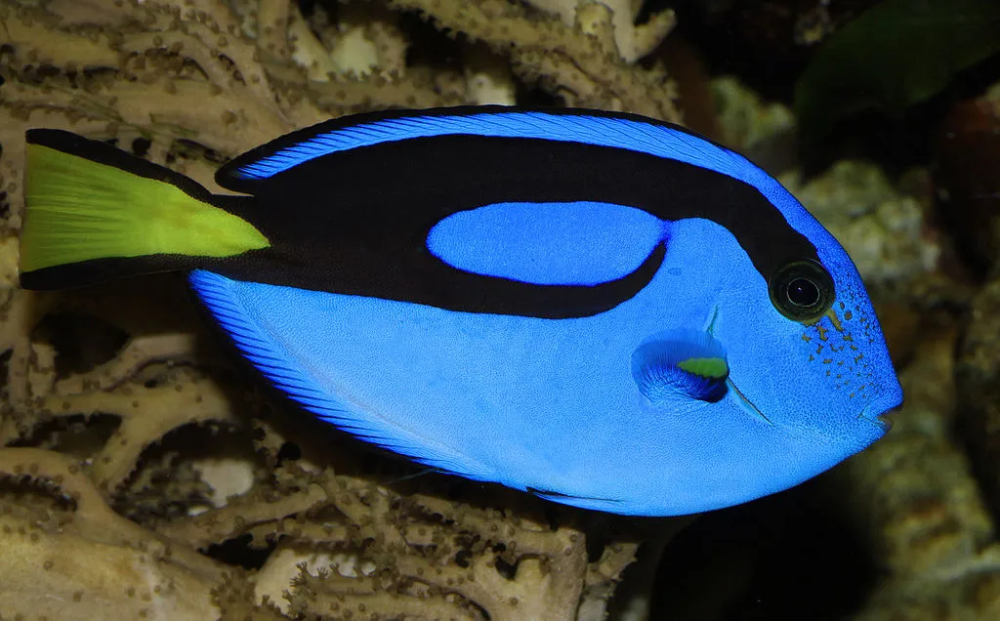The Blue Tang, scientifically known as Paracanthurus hepatus, is a marine fish species that has captured the hearts and imaginations of divers, aquarists, and ocean enthusiasts worldwide. Its vibrant coloration, graceful movements, and distinctive shape make it a standout among the diverse array of marine life inhabiting tropical coral reefs. From its ecological significance to its portrayal in popular culture, the Blue Tang holds a unique place in the underwater world. In this comprehensive exploration, we delve into the fascinating realm of the Blue Tang, uncovering its biology, behavior, habitat, conservation status, and cultural significance.
Biology and Physical Characteristics
The Blue Tang boasts a striking appearance characterized by its vibrant blue coloration, yellow tail fin, and black markings near its eyes and caudal peduncle. Its flattened, oval-shaped body is streamlined for efficient swimming through the water, while its small mouth and teeth are adapted for grazing on algae and small invertebrates. On average, adult Blue Tangs reach lengths of 12 to 15 centimeters (4.7 to 5.9 inches), although some individuals can grow slightly larger in optimal conditions.
One of the most intriguing features of the Blue Tang is its ability to undergo dramatic color changes throughout its life cycle. Juveniles exhibit a bright yellow coloration with blue spots, a stark contrast to the deep blue hue of adults. This unique coloration likely serves as a form of camouflage, helping young Blue Tangs blend in with their surroundings and evade predators.

Behavior and Ecology
Blue Tangs are predominantly herbivorous, feeding primarily on algae and other plant matter found on coral reefs. Their constant grazing plays a crucial role in controlling algae growth, which helps maintain the delicate balance of reef ecosystems. Despite their small size, Blue Tangs are swift and agile swimmers, capable of navigating through intricate coral formations with ease. They often form loose shoals, particularly during feeding or spawning events, providing safety in numbers against potential predators.
Reproduction in Blue Tangs typically occurs during warmer months when water temperatures are favorable for larval development. Mating rituals involve intricate courtship displays, with males vying for the attention of receptive females through various behaviors such as chasing and fin flaring. Once fertilized, the female releases hundreds of buoyant eggs into the water column, where they drift with the currents until hatching into larvae.
Habitat and Distribution
Blue Tangs are native to the tropical waters of the Indo-Pacific region, where they inhabit coral reefs and rocky outcrops at depths ranging from shallow coastal waters to deeper reef slopes. Their distribution extends from the eastern coast of Africa to the western Pacific Ocean, encompassing a vast range of marine habitats characterized by warm, clear waters rich in coral diversity.
Within their natural range, Blue Tangs are commonly encountered in association with coral reefs, where they seek refuge among branching corals and rocky crevices. These reef habitats provide essential resources such as food, shelter, and breeding grounds, making them integral to the survival of Blue Tang populations.
Conservation Status and Threats
Despite their widespread distribution, Blue Tangs face a myriad of threats that jeopardize their long-term survival. Habitat destruction, primarily driven by human activities such as coastal development, pollution, and overfishing, poses a significant threat to coral reef ecosystems and the species that depend on them. Additionally, the aquarium trade has contributed to the depletion of wild Blue Tang populations, as demand for these charismatic fish remains high among hobbyists and collectors.
In recent years, increased awareness of the importance of marine conservation has led to efforts aimed at protecting Blue Tangs and their habitats. Marine protected areas, such as marine parks and reserves, play a crucial role in safeguarding vulnerable marine species by providing refuge from destructive activities and promoting sustainable management practices.
Cultural Significance and Popular Culture
The Blue Tang holds a special place in popular culture, thanks in part to its prominent role in animated films and television shows. Perhaps most notably, the character of Dory, a friendly and forgetful Blue Tang, gained widespread acclaim following her appearance in Disney Pixar’s “Finding Nemo” and its sequel “Finding Dory.” These films not only brought attention to the plight of Blue Tangs in the wild but also helped foster a greater appreciation for marine life among audiences of all ages.
Beyond its portrayal in media, the Blue Tang has cultural significance in various coastal communities where it is valued for its aesthetic beauty and ecological importance. In some regions, Blue Tangs are revered as symbols of resilience and adaptability, serving as inspiration for artwork, folklore, and traditional ceremonies.
Conclusion
In conclusion, the Blue Tang stands as a testament to the marvels of marine biodiversity and the intricate interconnectedness of coral reef ecosystems. From its vibrant coloration to its essential role in maintaining reef health, this charismatic fish captivates the imagination and underscores the importance of conserving our oceans for future generations. By raising awareness, supporting conservation efforts, and fostering a deeper understanding of marine life, we can ensure that the Blue Tang and other inhabitants of our oceans continue to thrive in their natural habitats.









